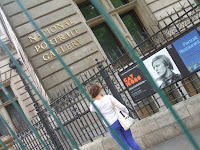through 18 October
In an age in which empty celebrity is exalted above achievement, in which 75% of UK girls aspire to be WAGs (according to this morning's Radio 5), an exhibit called Gay Icons poses some interesting questions: what is an icon? What is a gay icon? Is it someone to aspire to be? Someone who is inspirational? Someone specifically gay who is inspirational to other gay people?
 Well, the answer certainly does not lie within the confines of the portraits on display at the NPG. With minimal text accompanying the pictures, I was unsure as to the thinking behind the choices. A panel of 10 "selectors", chaired by Sandi Toksvig, chose a total of 60 portraits. It would have been very interesting if this panel had convened and argued over every single choice, Mercury Music Prize style, but it seems they made their choices in isolation.
Well, the answer certainly does not lie within the confines of the portraits on display at the NPG. With minimal text accompanying the pictures, I was unsure as to the thinking behind the choices. A panel of 10 "selectors", chaired by Sandi Toksvig, chose a total of 60 portraits. It would have been very interesting if this panel had convened and argued over every single choice, Mercury Music Prize style, but it seems they made their choices in isolation. Accordingly, each icon seems to have been chosen on the whims and criteria of the individual selector. And some conform to type: Lord Waheed Alli, who made his name in TV, chooses celebrities such as Will Young and Princess Diana. Sir Ian McKellen, a founder of Stonewall, chooses campaigners, such as Angela Mason and Harvey Milk. Writer Alan Hollinghurst chooses writers and composers such as Tchaikovsky and Gerard Manley Hopkins.
Where the exhibit picks up considerably is in the quirky choices. Graham Taylor? Nelson Mandela? Well, yes, if you are Sir Elton John and Billie Jean King, respectively. The first makes some kind of sense, given Elton's connection to Watford Football Club, while BJK speaks of Mandela's dignity in the face of oppression. But, clearly there is no unifying agreement on just what makes a gay icon.
The portraits are also of varying quality. Some are glossy PR shots, such as the one of the Village People (an Alli choice), while the one of Martina Navratilova (a Ben Summerskill choice) is a press shot taken after a Wimbledon triumph.
Chris Smith's choices include no fewer than three subjects who killed themselves, suggesting a link between gayness and tragedy or at least gay icon status and tragedy which is echoed by other selections such as Diana and Bessie Smith (selector Jackie Kay even states that Smith's bisexuality and alcoholism make her a perfect choice as an icon, to which I can only reply: WTF?!).
Surely, in the modern age one could sever this link. But, perhaps his point is that even such high achievers as Alan Turing and Virginia Woolf suffered from social prejudice or mental illness, making them vulnerable beings.
I found myself drawn to two photos, in particular, which hint at the subject's personality and some kind of otherworldly, steely inner quality which would allow for survival and success in the face of such travails. The first was a black and white shot of the social reformer Edward Carpenter (another McKellen choice), pictured in what looks like the entrance to a garden. There is something quite defiant about his jaunty pose, in three-quarters profile, and slightly slouching in his natty plus fours, hat and tie. Even his sandals can't detract from the portrait of a dandified mystic.
The second was of author Patricia Highsmith (a Sarah Waters choice), whose most famous creation, the shape-shifting Tom Ripley, continues to entrance modern readers and filmgoers. In a 1960s publicity shot, Highsmith, whose life spanned the pre-and post-Stonewall eras, gazes moodily at the viewer while holding a book. With her sleeves rolled up, and peering out from her tousled fringe, she oozes sensuality as well as gravitas. Clearly, a woman who means business and my kind of icon.
Accompanying the exhibit is a series of talks and performances, which includes a gig by the Raincoats on the 25th.
![Reblog this post [with Zemanta]](http://img.zemanta.com/reblog_e.png?x-id=2bfafd22-ed71-4251-a874-7cee89c84204)
1 comment:
<3 The Raincoats. Can't wait to see them next month!
Post a Comment